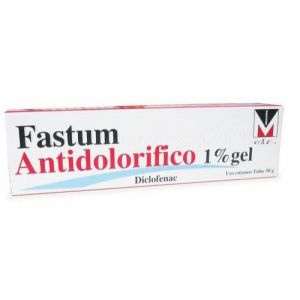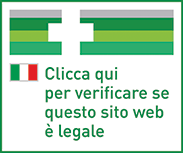Ship in Europe, Find out rates!

Fastum Painkiller Gel 1% Diclofenac Joint Pain 50g
MENARINI
Fastum Pain reliever gel is indicated for the local treatment of painful and inflammatory conditions of a rheumatic or traumatic nature of the joints, muscles, tendons and ligaments.
100 g of gel contain:
Active ingredient: DICLOFENAC DIETILAMMONIUM 1.16 g (equal to 1 g of Diclofenac sodium).
Excipients: Methyl parahydroxybenzoate (E218)
HOW TO USE
Depending on the extent of the painful areas or surfaces, 2-4 g of Fastum Pain Relief gel will be applied 3-4 times a day and rubbed lightly.
Adults over 18 years:
Apply Fastum Pain Relief gel 3 or 4 times a day on the area to be treated, rubbing lightly. The amount to be applied depends on the size of the affected part. For example, 2-4 g of Fastum Painkiller gel (quantity of variable size between a cherry and a walnut) are sufficient to treat an area of 400-800 cm2. After application, wash your hands, otherwise they will also be treated with the gel.
Warning: use only for short periods of treatment.
Teenagers aged 14 to 18:
Apply Fastum Pain Relief gel 3 or 4 times a day on the area to be treated, rubbing lightly. The amount to be applied depends on the size of the affected part. For example, 2-4 g of Fastum Painkiller gel (quantity of variable size between a cherry and a walnut) are sufficient to treat an area of 400-800 cm2. After application, wash your hands, otherwise they will also be treated with the gel.
If this product is needed for more than 7 days to relieve pain or if symptoms worsen, consult a doctor.
Children under the age of 14:
Insufficient data are available on efficacy and safety in children below 14 years of age (see also section 4.3. Contraindications).
Therefore, the use of Fastum Painkiller gel is contraindicated in children under 14 years of age.
Senior citizens:
The usual adult dosage can be used.
CONTRAINDICATIONS
Hypersensitivity to diclofenac or to any of the excipients.
Hypersensitivity to other non-steroidal anti-inflammatory drugs, such as acetylsalicylic acid.
Patients who have experienced asthma attacks, urticaria or acute rhinitis after taking acetylsalicylic acid or other non-steroidal anti-inflammatory drugs (NSAIDs).
Children:
use in children under the age of 14 is contraindicated.
WARNINGS
Do not use for prolonged treatments.
The possibility of systemic adverse events with the application of topical diclofenac cannot be excluded if the preparation is used on large skin areas and for a prolonged period (see summary of product characteristics of systemic forms of diclofenac).
Topical diclofenac should only be applied to intact, non-diseased skin, and not to skin wounds or open lesions. It should not be allowed to come into contact with eyes or mucous membranes and should not be ingested.
Discontinue treatment if skin rash develops after application of the product.
The concomitant use of systemic anti-inflammatory drugs is not recommended in elderly and / or gastric patients.
Patients with asthma, chronic obstructive diseases of the bronchi, allergic rhinitis or inflammation of the nasal mucosa (nasal polyp) react with asthma attacks, local inflammation of the skin or mucosa (Quincke's edema) or urticaria to antirheumatic treatment with NSAIDs more often than other patients.
The use, especially if prolonged, of other products for topical use, can give rise to sensitization phenomena. In this case it is necessary to interrupt the treatment and institute a suitable therapy.
To avoid any hypersensitivity or photosensitization phenomena, avoid exposure to direct sunlight including the solarium during the treatment and in the following two weeks.
The administration of Fastum Pain Relief gel should be discontinued in women who have fertility problems or who are undergoing fertility investigations. Topical diclofenac can be used with non-occlusive dressings, but should not be used with an occlusive dressing that does not allow air to pass.
Cutaneous use.
INTERACTIONS
Since the systemic absorption of diclofenac following topical application is very low, such interactions are very unlikely.
In high-dose and protracted treatments, the possibility of competition between absorbed diclofenac and other drugs with high plasma protein binding power should be borne in mind.
PREGNANCY AND BREASTFEEDING
Like other NSAIDs, Fastum Painkiller gel should not be administered in the third trimester of pregnancy and during breastfeeding.
The systemic concentration of diclofenac, compared with oral formulations, is lower after topical administration. Referring to experience with NSAID treatment for systemic administration, the following is recommended:
Inhibition of prostaglandin synthesis can adversely affect pregnancy and / or embryo / fetal development.
Results of epidemiological studies suggest an increased risk of miscarriage and cardiac malformation and gastroschisis after use of a prostaglandin synthesis inhibitor in early pregnancy. The absolute risk of cardiac malformations increased from less than 1% to approximately 1.5%. The risk was believed to increase with dose and duration of therapy. In animals, administration of prostaglandin synthesis inhibitors has been shown to cause increased pre- and post-implantation loss and embryo-fetal mortality.
Furthermore, an increased incidence of various malformations, including cardiovascular malformations, has been reported in animals given prostaglandin synthesis inhibitors during the organogenetic period.
During the first and second trimester of pregnancy, diclofenac should not be administered except in strictly necessary cases. If diclofenac is used by a woman attempting to conceive, or during the first and second trimester of pregnancy, the dose should be kept as low as possible and the duration of treatment as short as possible.
During the third trimester of pregnancy, all prostaglandin synthesis inhibitors can expose
the fetus to:
- cardiopulmonary toxicity (with premature closure of the arterial duct and pulmonary hypertension);
- renal dysfunction, which can progress to renal failure with oligo-hydroamnios;
the mother and the newborn, at the end of pregnancy, to:
possible prolongation of bleeding time, and antiplatelet effect which may occur even at very low doses;
inhibition of uterine contractions resulting in delayed or prolonged labor.
Consequently, diclofenac is contraindicated during the third trimester of pregnancy.
The use of Fastum Pain reliever gel, as well as any drug that inhibits prostaglandin synthesis and cyclooxygenase, is not recommended in women who intend to become pregnant.
Feeding time
Like other NSAIDs, diclofenac passes into breast milk in small amounts. However, no effects on the infant are expected at therapeutic doses of Fastum Painkiller. Due to the lack of controlled studies in breastfeeding women, the product should only be used during breastfeeding under the advice of a healthcare professional. In this circumstance, Fastum Pain Relief should not be applied to the breasts of nursing mothers, or elsewhere on large areas of the skin or for an extended period of time.
SIDE EFFECTS
Fastum Pain Relief gel is generally well tolerated.
Itching, redness, burning of the skin or rashes may occur.
The use of Fastum Painkiller gel, in combination with other medications containing diclofenac, can give rise to sensitization phenomena to light (photosensitivity), rash with blistering, eczema, erythema and skin reactions that may even be severe (Stevens syndrome -Johnson, Lyell's syndrome).
If Fastum Pain Relief gel is applied to relatively large areas of the skin and for a prolonged period, the possibility of systemic side effects cannot be completely excluded.
Adverse reactions are listed by frequency, most frequent first, using the following convention: common (≥ 1/100 to <1/10); uncommon (≥ 1 / 1,000 to <1/100); rare (≥ 1 / 10,000, <1 / 1,000); very rare (<1 / 10,000); Not known: cannot be estimated from the available data.
Fastum Painkiller 1% gel in pack of 50 gr
| Destination | Cost | Detail |
|---|---|---|
| Italy | €5,90* | 24/72H |
| Austria, France, Germany, Slovenia | € 13* | 3 days |
| Belgium, Luxembourg, Portugal, Netherlands, Spain | € 14* | 4 days |
| Bulgary, Cechia, Hungary, Poland, Romania, Slovakia | € 19* | 5 days |
| Denmark, Estonia, Finland, Ireland, Lithuania, Latvia ,Sweden | € 22* | 5 days |
| United Kingdom, Switzerland, Greece | € 30* | 7 days |
| Canada, USA | € 40 | 7 Days |
European shipments with express courier: FedEx, MBE, DHL
*For the shipment outside band B ther's an extra cost of 22€ *For the shipment outside band C ther's an extra cost of 30€ Delivery Times exclude Saturday and Holidays
For Islands and Areas of difficult Accessibility the shipments are made in 72 hours and the cost will be increased by 15€
